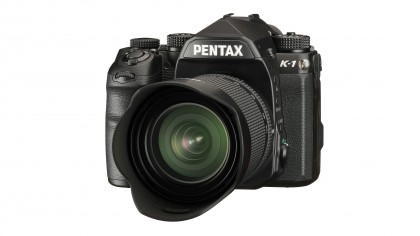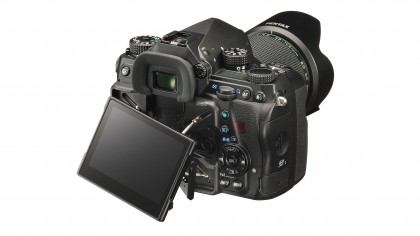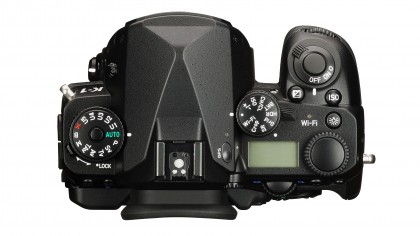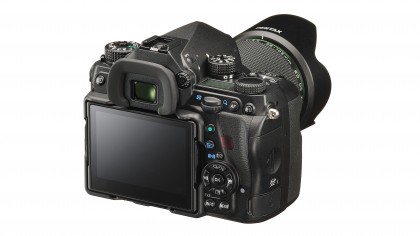Why you can trust TechRadar
When I first picked up the K-1 I thought it was comfortable to hold, and my opinion hasn't changed after using it for long periods of time. The front grip is nice and deep (from front to back) so your fingers have room to reach down and round, yet it's not too wide, so your fingers aren't stretched. It's also well-sculpted, and the textured coating is very tactile and 'grippy'.
On the back of the camera there's a slim but ergonomic thumb-ridge which, in combination with the front grip, makes the camera feel very safe in your grasp.
Overall the camera feels well made and durable thanks to the magnesium alloy construction. In addition, the dials are nice and solid, with a good level of torque. And as we expect with Pentax, all the controls, joints and ports are sealed to prevent the ingress of dust and moisture – this is a camera that you shouldn't have to quickly put away if it starts to rain when you're out on a shoot. It also continues to operate down to -10C.

However, during the course of my testing I found that the sealing cap for the mic port, and to a lesser extent the one for the headphones port, was frequently protruding from the camera. It must get caught by the strap or on clothing as the camera is carried, and starts to work loose, so it can't be relied upon to give a completely weatherproof seal.
The K-1 is designed for enthusiast photographers who want to take control of their camera and adjust settings on a frequent basis. Consequently it has a liberal covering of buttons and dials to give fast access to key features.
A new Smart Function Dial on the top plate is especially useful, with marked settings for Shake Reduction, Grid Display, HDR, Bracketing, continuous shooting speed, sensitivity, Wi-Fi and APS-C format Crop. Once you've turned the dial to the appropriate option, the desired setting is selected using another (unmarked) chunky dial on the top plate. It takes a little while to get used having these features on a dial rather than finding them in a menu or looking for dedicated buttons, but it's neat and convenient.

It's not without its quirks though. For example, after setting the dial to the Bracketing option and then adjusting the exposure range of the three shoots, I discovered that it's not possible to turn off the bracketing using the dials. I had expected to be able to reduce the exposure variation to zero. Instead you need to access the drive mode options (via the up navigation key) and switch the camera back to single-frame shooting. This needs to be ironed out with a firmware update.
I tended to leave the Smart Function Dial set sensitivity, so that I could adjust the value quickly with the camera held to my eye.
Exposure compensation is set in a fairly traditional way, by pressing the dedicated button near the shutter release and rotating the dial on the back of the camera near the thumb rest.
The standard information display on the main screen is clear, and it changes promptly as settings are altered – and it's one of the less-dated looking screens that the K-1 displays (see below for more on this). It shows whether the camera is in AF point selection mode; if it isn't, this can be selected with the press of a button. Once activated, the desired AF point is chosen via the navigation keys.

It's a neat system that compensates pretty well for the lack of a dedicated AF point selection control, but there are times when you forget to check the mode, and you end making settings adjustments instead of moving the AF point.
Pressing the Info button on the back of the camera activates a screen that shows 20 features which can be adjusted. The icons are small, however, and the purpose of some is not immediately clear. This is also the case with other menus, and one criticism we've levelled at Pentax SLRs in recent times is that their menus look dated; the same can be said of the K-1 – it's not a major issue, but it's still a fact.
Time and use will reveal an icon's purpose, and they'll eventually become familiar, but it could lead to some confusion or frustration in the early days. This could be addressed with firmware updates, but they take time and money. Of course a key reason for sticking with this interface is to help users who want to upgrade or swap between cameras on a frequent basis.

The K1's viewfinder is nice and bright, giving a very slight boost to contrast and a little warmth to the scene, making it a tiny bit more photogenic than it is in reality. There's a just-visible fine-grained texture, and from some angles there's even a faint radiating pattern of concentric circles.
Images can also be composed on the 3.2-inch 1,037,000-dot LCD, which provides a clear view. This is mounted on an unusual tilting mechanism which enables the screen to be pivoted around through 35 degrees horizontally and 44 degrees vertically; it can also be pulled out for waist-level shooting. I found the articulation useful when shooting with the camera in landscape orientation, or at a slight angle, but it's more restricted when you're shooting in portrait format.
A tilting or vari-angle screen is sometimes considered a weak point on a camera, but I was encouraged to test the strength of the K-1's mechanism by holding the screen and dangling the camera, swinging it around to test the movement. It certainly proves the point – it doesn't feel like it will give way or detach easily.
